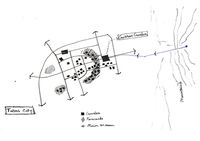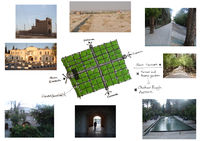Golshan Garden - Iran: Difference between revisions
Jump to navigation
Jump to search
Hamid.gohari (talk | contribs) |
Hamid.gohari (talk | contribs) |
||
| Line 40: | Line 40: | ||
==Which idea of ‘design with nature’ guides the design concept of this site?== | ==Which idea of ‘design with nature’ guides the design concept of this site?== | ||
*'' | *''The design pattern of this Persian garden is based on the Chaharbagh pattern. The geometry shape of the garden is square, which makes it different from other Persian gardens. From that, the length and width of the garden are equal and there are three main crossed pathways in the garden. There are, also, two crossed water streams which always have permanent running water. Another feature that makes the garden different one is different type of fruit trees with different weather climates in the garden. At this time, two important features of this garden are neglected: water and plant diversity. Drought, the destruction of traditional water supply systems and intensive agriculture around the city are the main causes of water loss in the garden. The new planting pattern was done regardless of its historical context.'' | ||
== Which challenges is this landscape facing?== | == Which challenges is this landscape facing?== | ||
Revision as of 18:39, 4 November 2018
>>>Back to Case Studies Overview
>>>Glowing with Water
| Name | Golshan Garden | |
| Place | Tabas city | |
| Country | Iran | |
| Author(s) | Hamid Gohari | |
| World Heritage | ... | |
|
| ||
Why is this case relevant?
- Golshan Garden is one of the most important gardens and one of the unique historical heritage of Iran, which is estimated to be about 200 years old. This garden is located in Tabas city, in the range of connection of two main deserts, the Lut Desert and Kavir Desert. Generally, this garden is inherited the main elements from the Persian garden including the special structure, water and vegetation, and the palace. But specifically, this garden has different geometry, varied vegetation species, and special water distribution network, which make it unique one from the other Persian gardens. Golshan garden has evolved in the context of the Persian city and is one of the main features in the city’s structure. Over the years, its shape and function have changed to suit the needs of the city and created this amazing complex in the heart of the desert.
Which idea of ‘design with nature’ guides the design concept of this site?
- The design pattern of this Persian garden is based on the Chaharbagh pattern. The geometry shape of the garden is square, which makes it different from other Persian gardens. From that, the length and width of the garden are equal and there are three main crossed pathways in the garden. There are, also, two crossed water streams which always have permanent running water. Another feature that makes the garden different one is different type of fruit trees with different weather climates in the garden. At this time, two important features of this garden are neglected: water and plant diversity. Drought, the destruction of traditional water supply systems and intensive agriculture around the city are the main causes of water loss in the garden. The new planting pattern was done regardless of its historical context.
Which challenges is this landscape facing?
- Here you discuss the types of negative impact you are observing but you can also mention new functions that could give a development opportunity
What would be your strategy for improvement?
Finally, please share some ideas of how you would initiate positive change for your heritage area
Image Gallery
- Yourimage.jpg
your image text and source
- Yourimage.jpg
your image text and source
- Yourimage.jpg
your image text and source
- Yourimage.jpg
your image text and source
- Yourimage.jpg
your image text and source
- Yourimage.jpg
your image text and source
References
- Author Year: Title, publisher, edition, page, ...
- etc.
- Website Year: Link, keyword, ...
- etc.


